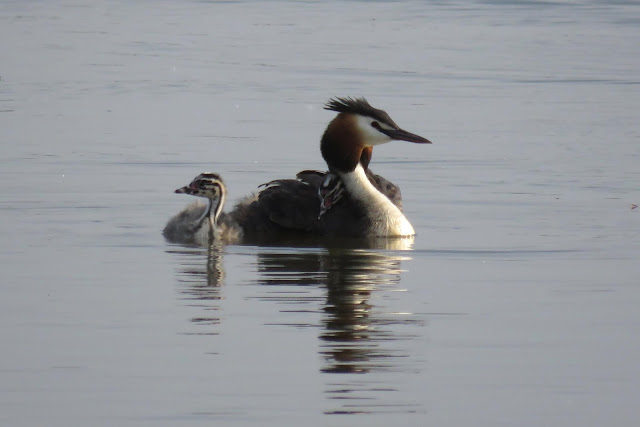RSPB Rainham Marshes 27th-28th May 2018
It is nice to have so much to write about at work at the
moment and as spring draws to a close and the emphasis moves over to breeding
success and the wondrousness of insects it is rewarding to snatch a few minutes
here and there to absorb the marvels around you.
The great storm of Saturday evening prompted an early start
yesterday and a yomp down to Aveley Bay to see the last remnants of Arctic
bound migration in action. Twenty-one spangled Grey Plovers – most in their
best tuxedos were dotted around the mud along with 51 rotund Ringed Plovers, 11
chequerboard Sanderling and a very pale Dunlin with a restricted black belly
patch. A pristine sum plum Turnstone flicked seaweed on the rocks and three
Avocet and a couple of Oystercatchers were noted along with our resident
Redshanks.
 |
| Some of the Grey Plover flock |
 |
| Grey Plover - Andy Reid |
 | |
| Sanderling |
And a great videon from Pat Hart here -
A glance behind revealed a Spoonbill on the History Fields
but I could see no black and suspected that it was a new adult. Our Marsh Harriers were getting a serious
hammering from the Redshanks and Lapwings and every Carrion Crow and Magpie but
not Rook was given similar short shrift.
 |
| Quality Spoonbill |
The rest of the day was largely spent on the riverwall
opposite the centre engaging with the public using our path with able
assistance from Sim, Robyn, Amy and my eyes on the sky Pat, Ruth and Phil. By
the end of proceedings we had notched up a nice round 90 species including a
few additional Grey plovers, Turnstone and Dunlin, five Common Sandpipers,
Greenshank, Ruff, several gleaming Med Gulls, sooty Black Terns, Yellow
Wagtail, dashing Hobbies and even the Raven.
Today I repeated my early visited but with clear skies and
no rain there was un-surprisingly a dearth of waders in Aveley Bay although two
Sanderling did appear from nowhere. Fifteen Ringed Plover and a Dunlin left
quickly and headed high and north into the hazy blue while Shelducks chaperoned three broods.
 |
| Shelduck |
And another Pat Hart video...
The Spoonbill was still dozing on the History Pool and
photos confirm it to be a new adult as I suspected. Hobbies and Cuckoos zipped around but it was
ornithologically quieter than Sunday.
 |
| Spoonbill - Phil Wallace |
 |
| Hobby - Les Andrews |
A short pop down to the woodland allowed me to find several
more of the smart little hover with the big nose – Anasimyia lineata - that I first found on Tuesday along with Myathropa florea, Eristalis arbustorum, Xanthogramma pedissequum, Tropidia scita and some Parhelophilus on the now very fragrant
Dogwood. Phil Collins has successfully identified one of the males as P. versicolor (the one without the stray
hair tuft!) so we now just have to confirm whether we have his tufted compatriot P.frutetorum!
 |
| Anasimyia lineata |
 |
| Anasimyia lineata - not sure how i have missed this species here before |
Broad-bodied Chasers dashed around the Cordite and Hairy Hawkers
and three Damsel species were around the woodland bridge where I also saw Neoascia interrupta (making 25 species this week) – a really tiny
hover – and a not so tiny Grass Snake that sinuously slithered through the
weeds.
I did not linger long out as it was seriously hot and humid
and was not expecting to have Ian Bradshaw calmly announce at just before five that
he had seen a male Mandarin out on the marsh.
He seemed genuinely surprised at my wide eyed look and vaguely twitching
limbs...
Now, I have a bit of history with this species on the
reserve. There have only ever been two records and the last was on the 12th
March 2009 – which was perversely the last day off sick that I had. I was
phoned about the bird and then disseminated the news, ensuring that all the
locals connected. It was gone the next day and so nine years later I was
somewhat keen to connect with this drake.
But where was it? From the Butts Hide of course and so at
5pm as we closed up I picked up my gear and headed back out into the heat for a
full circuit with the hope of a reserve life tick at the end of it.
The birding gods were kind and a quick scan from the Butts
Hide revealed this drake snoozing in the lush grass and although I could only
see its head and an orange sail I was a very happy bunny.
 |
| Mandarin - exciting isn't it? |
 |
| Happy Bunny |
My quick walk provided me with five broods of Shoveler, two
of Pochard and Great Crested Grebe and a plethora of Mallard, Coot and goose
broods indicating that a very good breeding season is underway.
 |
| Great Crested Grebe family |
 |
| Pochard family |
The male Marsh Harrier was once again taking a beating from
over forty frantic waders and a Water Rail became the 101st species for the
three days of the Bank Holiday.
Time for a cold beer I think...


No comments:
Post a Comment